Transformations of Functions
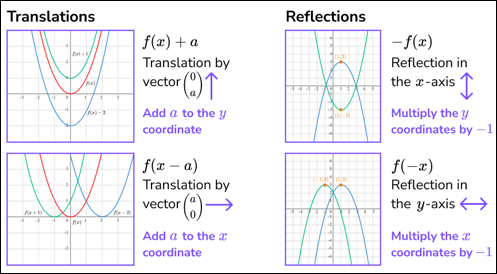
Transformation of Functions
Section Overview
● Identify a function reflection given an equation.
● Identify a function dilation given an equation.
● Sketch a graph of a transformed function given the graph of the
original function.
Key Vocabulary:
Vertical shift - A transformation of the graph of y = f(x),
represented by h(x) = f(x) ± c, in which the
graph is shifted upward or downward c units respectively (c is a positive
real number).
Horizontal shift - A transformation of the graph of y = f(x),
represented by h(x) = f(x ± c), in which the graph
is shifted to the left or to the right c units respectively (c is a
positive real number).
Flip - A transformation of the graph of y = f(x), represented by h(x) = -f(x), in which the graph is flipped over the x-axis. The function is multiplied by -1 to get -f(x).
Nonrigid transformations - A transformation of a graph that cause a
distortion—a change in the shape of the graph.
The standard form of a
quadratic function presents the function in the form: f (x) = a(x
– h)2 + k
“a” Represents Stretching or Compressing
“x” Represents the x-value of a point on the coordinate plane
“h” Represents moving parent function (original) left and right
“k” Represents moving parent function up and down
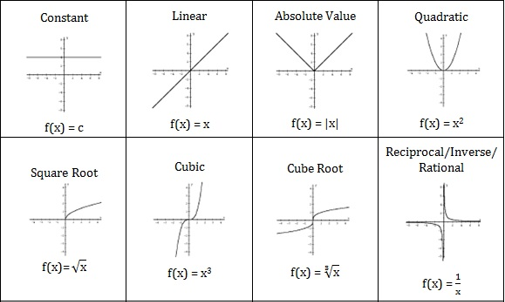 |
Shift Up and Down by Changing
the Value of k
You can represent a vertical
(up, down) shift of the graph of f(x) = x2 by
adding or subtracting a constant, k.
f(x) = x2 + k
If k > 0, the graph
shifts upward, whereas if k < 0, the graph shifts downward.
Example 1: Determine
the equation for the graph of f(x) = x2 that has been shifted up
4 units. Also, determine the equation for the graph of f(x) = x2 that
has been shifted down 4 units.
Solution:
The equation for the
graph of f(x) = x2 that has been shifted
up 4 units is f(x) = x2
+ 4.
The equation for the graph of f(x)
= x2 that
has been shifted down 4 units is f(x)
= x2 – 4.
Shifting Left and Right by
Changing Value of h
You can represent a horizontal (left, right) shift of the graph
of f(x) = x2 by adding or subtracting
a constant, h, to the variable x, before squaring.
f(x) = (x – h)2
If h > 0, the graph shifts toward the right
Example 1:
Determine the equation for the
graph of f(x) = x2 that has
been shifted right 2 units. Also, determine the equation for the graph of f(x)
= x2 that has been shifted left 2 units.
Solution:
The equation for the graph of f(x) = x2 that has been shifted right 2 units
is f(x) = (x – 2)2.
The equation for the graph of f(x) = x2 that has been shifted left 2 units is f(x) = (x + 2)2.
Stretching and Compressing by changing the
value of a
You can represent a stretch or compression (narrowing,
widening) of the graph of f(x) = x2 by multiplying the squared variable by a constant, a.
f(x) = ax2
The magnitude of |a|= ax2 indicates the
stretch of the graph. If |a|> 1, the point associated with a
particular x-value shifts farther from the -axis, so the graph
appears to become narrower, and there is a vertical stretch. But if |a|< 1, the point
associated with a particular x-value shifts closer to the x-axis, so the graph appears
to become wider, but in fact there is a vertical compression.
Solution:
The equation for the
graph of f(x) = x2 that has been compressed
vertically by a factor of 1/2 is f(x)
= (½) x2
The
equation for the graph of f(x)
= x2 that has been vertically stretched by a factor of 3 is
f(x) = 3x2.
Let’s Practice.
1) The minimum point on the
graph of the function y = f(x) is (-2, -4). What is the minimum point on the graph of the
function y = f(x) + 7?
|
 |
2) If
the graph of the function y = 2x is
reflected over the x-axis, the equation of the reflection is
___________.
 |
3) Function f(x) is shown in the table below. Which of the choices
represents the value of h(3), given that h(x) = f(x) + 4?
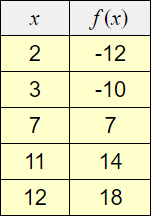 |
 |
 |
4) Function y = f(x) has been shifted 3 units to the right and 5 units down.
Which of the following equations represents these changes?
A) y = f(x + 3) – 5 B) y = f(x – 3) + 5
C) y = f(x + 3) + 5 D)y = f(x – 3) - 5
 |
5) Which of the following
statements describes the transformation indicated by: f(x) = x2 becomes g(x) = (x – 3)2
A) Function f was translated (shifted) horizontally 3 units to the
left. |
 |
 |
Rotations of Graphs
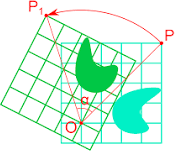
Section Overview
· Understand the transformations on the coordinates of a point
when it is rotated about the origin on the coordinate plane by 90°
counterclockwise.
· Identify equivalent rotations on the coordinate plane.
· Identify the image of a point, line segment, or shape after a
given rotation about the origin.
· Rotate points, line segments, and shapes about the origin by
multiples of 90°.
· Understand the properties of rotation about a point.
Key Vocabulary:
Rotation - A transformation where a figure is turned about a fixed
point. Also called a turn.
Center of Rotation - A fixed point which shapes move in a circular motion to a new
position.
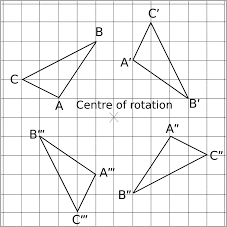
Rotational Symmetry - When a figure can be turned less than 360° about its center
and still look like the original.
A rotation is a
transformation in which a figure is turned around a fixed point, called the center
of rotation.
A rotated figures has the same size and shape as the original figure.
The newly rotated figure is called an image of the original figure.

The points of an image on a
coordinate grid are labeled with a ′ (prime) following the letter.
Here
are the rotation rules:
● 90° clockwise rotation: (x, y) becomes (y, -x)
● 90° counterclockwise rotation: (x, y) becomes (-y,
x)
● 180° clockwise and counterclockwise rotation: (x, y)
becomes (-x, -y)
● 270° clockwise rotation: (x, y) becomes (-y,
x)
● 270° counterclockwise rotation: (x, y) becomes (y,
-x)
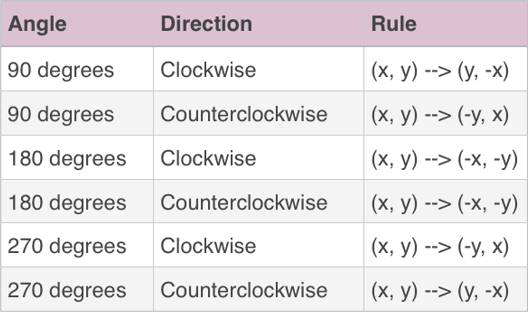
·
A
(-4, 7) becomes A′ (7, 4)
·
B
(-6, 1) becomes B′
(1, 6)
·
C
(-2, 1) becomes C′
(1, 2)
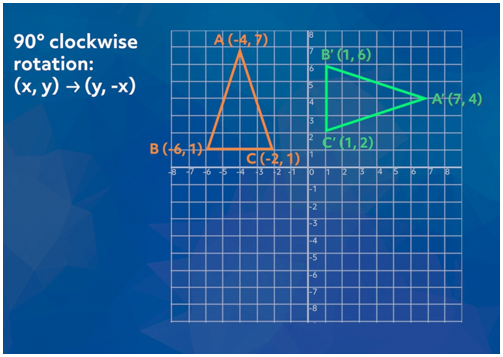 |
Let’s
take a look at another rotation. Let’s rotate triangle ABC 180° about the
origin counterclockwise, although, rotating a figure 180° clockwise and counterclockwise
uses the same rule, which is (x, y) becomes (-x, -y),
where the coordinates of the vertices of the rotated triangle are the
coordinates of the original triangle with the opposite sign. Let’s apply the
rule to the vertices to create the new triangle A′B′C′:
·
A
(2, 7) becomes A′
(-2, -7)
·
B
(2, 1) becomes B′
(-2, -1)
·
C
(6, 1) becomes C′
(-6, -1)
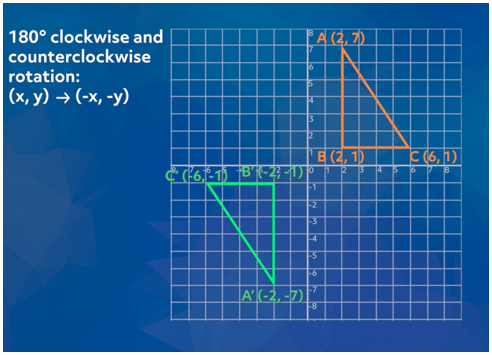 |
Here is quadrilateral ABCD. To rotate quadrilateral ABCD 90°
counterclockwise about the origin we will use the rule (x, y)
becomes (-y, x). Let’s apply the rules to the vertices to create
quadrilateral A′B′C′D′:
·
A
(-8, -2) becomes A′ (2, -8)
·
B
(-7, -7) becomes B′ (7, -7)
·
C
(-2, -6) becomes C′ (6, -2)
·
D
(-3, -2) becomes D′ (2, -3)
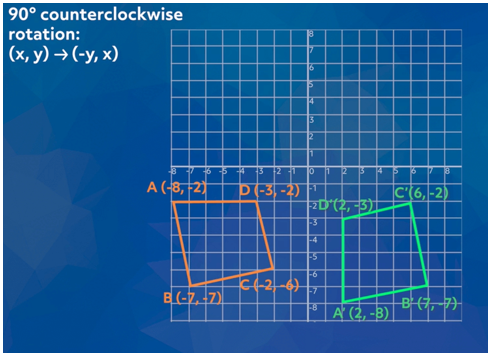 |
Let’s Practice.
